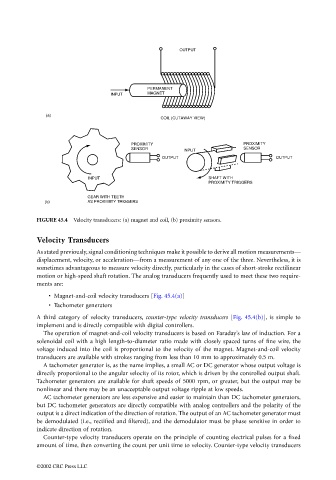Page 1168 - The Mechatronics Handbook
P. 1168
OUTPUT
ν PERMANENT
INPUT MAGNET
(a)
COIL (CUTAWAY VIEW)
ω PROXIMITY PROXIMITY
SENSOR INPUT SENSOR
OUTPUT OUTPUT
ω
INPUT SHAFT WITH
PROXIMITY TRIGGERS
GEAR WITH TEETH
(b) AS PROXIMITY TRIGGERS
FIGURE 45.4 Velocity transducers: (a) magnet and coil, (b) proximity sensors.
Velocity Transducers
As stated previously, signal conditioning techniques make it possible to derive all motion measurements—
displacement, velocity, or acceleration—from a measurement of any one of the three. Nevertheless, it is
sometimes advantageous to measure velocity directly, particularly in the cases of short-stroke rectilinear
motion or high-speed shaft rotation. The analog transducers frequently used to meet these two require-
ments are:
• Magnet-and-coil velocity transducers [Fig. 45.4(a)]
• Tachometer generators
A third category of velocity transducers, counter-type velocity transducers [Fig. 45.4(b)], is simple to
implement and is directly compatible with digital controllers.
The operation of magnet-and-coil velocity transducers is based on Faraday’s law of induction. For a
solenoidal coil with a high length-to-diameter ratio made with closely spaced turns of fine wire, the
voltage induced into the coil is proportional to the velocity of the magnet. Magnet-and-coil velocity
transducers are available with strokes ranging from less than 10 mm to approximately 0.5 m.
A tachometer generator is, as the name implies, a small AC or DC generator whose output voltage is
directly proportional to the angular velocity of its rotor, which is driven by the controlled output shaft.
Tachometer generators are available for shaft speeds of 5000 rpm, or greater, but the output may be
nonlinear and there may be an unacceptable output voltage ripple at low speeds.
AC tachometer generators are less expensive and easier to maintain than DC tachometer generators,
but DC tachometer generators are directly compatible with analog controllers and the polarity of the
output is a direct indication of the direction of rotation. The output of an AC tachometer generator must
be demodulated (i.e., rectified and filtered), and the demodulator must be phase sensitive in order to
indicate direction of rotation.
Counter-type velocity transducers operate on the principle of counting electrical pulses for a fixed
amount of time, then converting the count per unit time to velocity. Counter-type velocity transducers
©2002 CRC Press LLC

